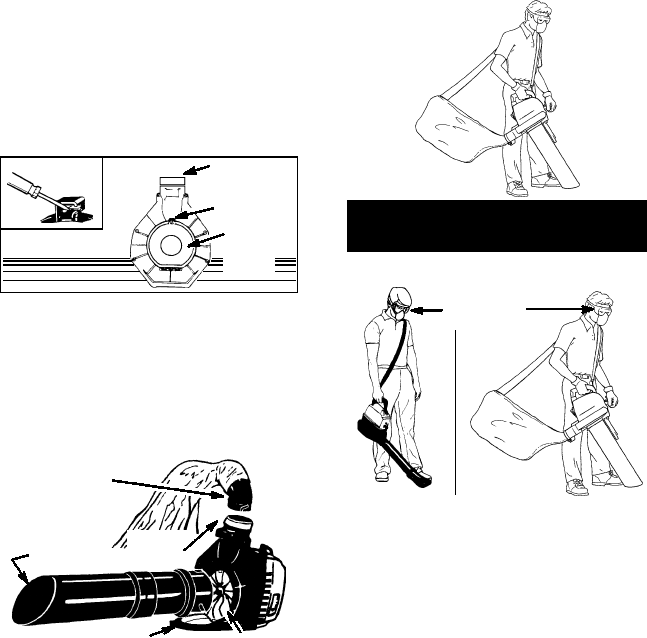
-- 4 --
VACUUM TUBE ASSEMBLY
D
Remove the blower tube from the engine.
D
Insert a screwdriver into the latch area on
the vacuum inlet cover.
D
Gently tilt the tip ofthe screwdriver forward
towardblower outlet while pulling up onthe
vacuum inlet cover with your other hand.
D
Hold the vacuum inlet cover open until up-
per vacuum tube is installed.
Latch Area
Latch Area
Blower
Outlet
Vacuum
Inlet
Cover
D
Assemble upper vacuum to unit; turn
clockwise to tighten.
D
Align slanted end of lower vacuum tube as
shown. Push lower vacuum tube into up-
per vacuum tube
.
D
Insert theelbow tube into the bloweroutlet.
Make sure elbow tube is curved to the left.
D
Turn tube counterclockwise to tighten.
Slanted
End
Vacuum Inlet
Vacuum Inlet Cover
Blower
Outlet
Elbow Tube
Curved To
The Left
D
When converting back to the blower fea-
ture, make sure that the latch on the vacu-
um inlet cover is securely fastened.
SHOULDER STRAP ADJUSTMENT
(for vacuum bag)
D
Hold the unit as shown bel ow.
D
Pass the shoulder strap over your head
and onto your left shoulder.
D
Snap the hook onto the retainer on the top
handle.
D
Extend your right arm toward the rear of
the vacuum bag.
D
Adjust shoulder strap until the vacuum
bag/shoulder strap seam lies between
your thumb and index finger.
D
Make sure air flows freely from the elbow
tube into bag. If bag is kinked, the unit will
not operate properly.
SAFETY RULES
USING YOUR UNIT
YOU MUST make sure the tubes are secure
before using the unit.
BLOWER
Eye
Protection
V ACUUM
OPERATING TIPS
D
Toreduce the risk ofhearing lossassociat-
ed with sound level(s), hearing protection
is required.
D
Toreduce the risk of injury associated with
contacting rotating parts, stop the engine
before installing or removing attachments.
Do not operate without guards in place.
D
Operate power equipment only at reason-
able hours --not early in themorning orlate
at night when people might be disturbed.
Comply with times listed in local ordi-
nances. Usual recommendations are9:00
a.m. to 5:00 p.m., Monday through Satur-
day.
D
Toreduce noise levels, limit the num ber of
pieces of equipment used at any one time.
D
To reduce noise levels, operate power
blowers at the lowest possible throttle
speed to do the job.
D
Use rakes and brooms to loosen debri s
before blowing.
D
In dusty conditions, slightly dampen sur-
faces or use a mister attachment when
water is available.
D
Conserve water by using power blowers
instead of hoses for many lawn and gar-
den applications, including areas such as










